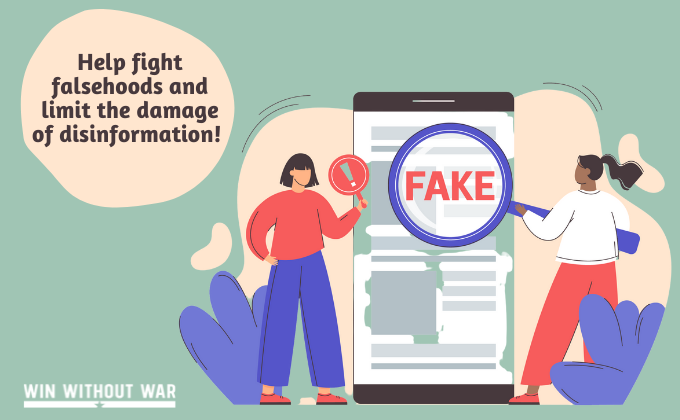Fake News in a Time of War

Last Updated on February 25, 2022.
As Russian missiles fly in Ukraine we all want to stay updated on the latest news and information coming from the conflict. Unfortunately, social media can be a powerful tool in the spread of bad information from dishonest actors or people who are simply misinformed.
In the last few days misinformation and outright deceptions have spread across the internet like wildfire. Whether it is the sophisticated disinformation network of Vladimir Putin, fake videos claiming to show scenes from the war, or counterfeit Instagram accounts spreading false memes, the effect is the same. It makes it harder for ALL of us to get accurate information about the war.
Did you know fake content often spreads more quickly than the truth in times of crisis? When urgency is paired with algorithms that uplift the most shocking and inflammatory content disinformation thrives. When we spread lies, falsehoods, or news that is just plain wrong, even unknowingly, we obscure the truth, make it harder to help those in need, and help bad actors build power.
That’s why, with tensions high and the potential for disinformation on the rise, we’ve got 10 tips on spotting bad content so you can avoid spreading and amplifying misinformation. Help us fight falsehoods and limit the damage by being a hero in the fight against disinfo!
- Before you share something that is sensational use “SIFT”: Stop, Investigate the source, Find better coverage, Trace the claims to the original source.
This Twitter thread has more information on how to do each step. - Check the source. All social media platforms have fake accounts that spread disinformation to gain views and followers. Here are a couple easy ways you can spot the fakers.
- Follow trusted and established news sources. Look to reporters who have a track record covering the issues you are interested in (you’ll learn a lot from their bios). Go to well-established news outlets that have the size and capacity to employ fact-checkers.
- Avoid partisan news sources, even the ones that align with your own beliefs. A self-affirming news bubble means we miss stories that conflict with our worldview. Different perspectives help us fully understand what is happening in the world.
- Report fake and abusive accounts. Additionally, block these accounts from your own timeline, which will keep your timeline clean and limit the number of people who see harmful content.
- Don’t share disinformation to point out it is disinformation. The best way to limit the reach of harmful accounts is to starve them of the online attention they need to spread lies. If Twitter is your place, check out this really great and detailed resource about how to avoid spreading propaganda from Defend Democracy.
- Don’t open and don’t forward emails from people you do not know or trust. While social media can be a primary platform for disinformation, there are still plenty of folks who will spread inaccurate or false information through spam.
- Practice digital humility. Recognize that any of us can get caught up in the moment and share disinformation. We need to be vigilant all of the time we are online.
- Remember: accuracy is better than speed. It is never harmful to take a few minutes to evaluate information before you share.
- Finally, In a time of crisis it is easy to become glued to our screens and doom-scroll. Please practice self care. Close your laptop, turn off your phone, and take some time to decompress. To be a resilient movement, we need resilient people who can be in the struggle for peace in the long haul. You and your health matter. Twitter will still be there when you get back.
Need more information? See the resources listed at the bottom of this page from some great organizations who want to help you break through the noise and find reliable news sources.
As people who care about peace and justice, we all have our part to play. It is up to all of us to work to ensure that our online environment centers the truth and diminishes the power of those who lie to cause fear and chaos.
|
Resources Los Angeles Times, “The other front in Putin’s Ukraine invasion: online disinformation” Gizmodo, “10 Photos and Videos From Russia’s Invasion of Ukraine That Are Actually Fake” Input Magazine, “Scammy Instagram ‘war pages’ are capitalizing on Ukraine conflict” MIT News, “Study: On Twitter, false news travels faster than true stories“ Mike Caulfield: Twitter thread explaining the SIFT Method Keep Calm and Log On, “More tips for identifying fake accounts’ Defend Democracy, “Twitter 101: the basics of dealing with disinformation, lies and propaganda |
Share this!
February 25, 2022


